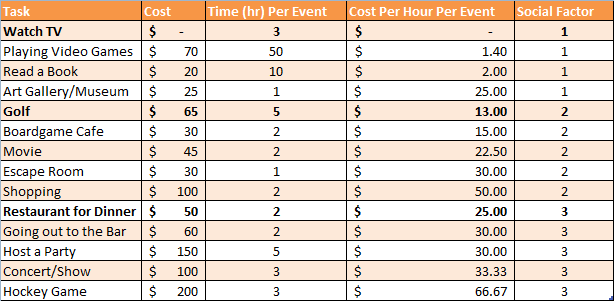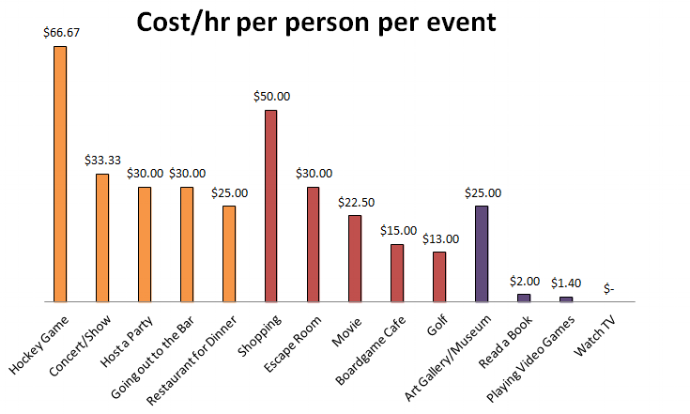Who doesn't like to have fun? Whether it's a weekend day, or a weekday night, we all need to get away from the stressful work life (or just life) from time to time.
Entertainment should always be part of a budget, and it's quite easy to get carried away when it comes to spending a night on the town or having fun and being sociable during the week. To discuss this topic on more of a less serious level, I've devised a list of various activities that people partake in to fulfill their need of "fun", and go on to show which activities are the most cost effective and which are the least. The list looks at the estimated cost for one person to partake in the activity for one evening, the estimate time an individual would experience the activity for, the social factor ranked 1 (low) to 3 (high) that measures the inherent level of social interaction while partaking in the activity, and finally the resulting cost per hour per event that measures the relative ranking of my "fun cost rate" metric.
This list proves that it's great to be an introvert (please note my sarcastic sense of humor throughout this post).
Activity #1: Eating Out at a Restaurant; Fun Cost Rate: $25/hr per event; Social Factor: 3
This one is probably everyone's favorite thing to do with their significant other, or a friend or group of friends. Based on a stats Canada survey, in 2015, the average Canadian household spent $2,502 a year on eating out. This was a 12% increase from the previous year. If we assume a linear growth trend to 2017, this would mean that the average Canadian household in 2017 spends on average $3,138 (in Alberta where I reside, the average is a lot higher than the rest of the country, totaling $3,058 average household spend in 2015). Given that the medium Canadian household income in 2015 was $80,940, this would mean that the average household spent 3.1% of their total net income just on eating out.
Activity #2: Going to an NHL game; Fun Cost Rate: $67/hr per event; Social Factor: 3
Living in Canada, this is a pretty common and exciting thing for people to do. Unfortunately, ticket prices at Canadian NHL team arenas on average cost much more than our American team counterparts. Which makes this activity the top of my list for worst fun cost efficiency. Here in Edmonton, Oilers ticket prices are one of the highest in the league. Regular season ticket prices are easily $200 per person if you want decent seats (nosebleeds might reduce your fun cost rate, but then you'd have to sit amongst the out of town Atom and Pee-Wee level teams and their parents). After you've factored in the ticket price of the game, as well as the extremely overpriced concession food you will buy while at the game, my estimated cost per person is $200 (which i would argue is actually on the under conservative side) for 3 hours of entertainment.
Activity #3: Going to See a Movie; Fun Cost Rate: $22.50/hr per event; Social Factor 2
Unless you are seeing a movie by yourself, I've rated this activity as a 2 social factor because I figured you'll probably make some sort of interaction, head nod, sigh, or brief gab while going to see a movie with your date. Movie ticket prices seem to always go up on an annual basis at a faster rate than inflation. Going to the movies used to be a cheap alternative to going out with your date, but nowadays it costs just as much as eating at a restaurant. Movie ticket prices plus the popcorn combo that almost requires a payday loan can easily make this a $45 night for one person. Also, this activity can easily go hand in hand with eating out at a restaurant, which would obviously inflate the fun cost rate. Therefore, being a correlated activity, we could easily assume that "dinner and a movie" would equal $47.50/hr per person. That better be a good a movie, or hope that your date is in the habit of paying for the both of you.
Activity #4: Golfing; Fun Cost Rate: $13/hr per event; Social Factor 2
I do realize that golfing isn't really a "going out" alternative, but I would still consider it a form of entertainment that one can partake in with a few friends for an enjoyable morning or afternoon. Assuming an average round of golf costs $65, and that your four-some can shoot around 100 give or take a few strokes and finish the round in 5 hours, this results in a pretty cost efficient fun activity per person. If a qualitative metric of "rage" were included in this study, golf would be the worst option.
Activity #5: Playing Video Games; Fun Cost Rate: $1.40/hr per event; Social Factor 1
Who doesn't like playing video games for 5 hours straight until 3am? Prices for new "good" video games cost around $70 or $80. This may seem quite high but given that many newer games that continue to evolve in having more in depth story lines and game play, total game play to finish the game or complete can easily take up to 50 hours. Even if one is playing a sports video game like NHL or MLB, one game takes maybe 30 minutes, and to finish a full 82 game NHL season would require at least 40 hours of play (don't forget about playoff games). If this isn't bank for your buck, then I don't know what is. The only downside is that you are engaging in this activity likely by yourself and there is no social aspect to it whatsoever (assuming you only have one controller so a friend can't play). This gets a social factor of 1.
In addition, other activities with low social factors, such as reading and watching TV, require very little cost per hour rates (TV of course requires you to go out and buy a TV, but that's a one time up front cost which you would have had to do regardless of whether you watch 1 hour or 100 hours of TV a month). The table below and supporting graph show the activities discussed above, as well as additional ones, in terms of cost per hour per person and how each of them compare to one another relatively within the same social factor and across different social factors:
Table 1: Fun Cost Rate Calculation Per Person
Figure 1: Fun Cost Rate Per Social Factor Grouping
Orange: Social Factor 3
Red: Social Factor 2
Purple: Social Factor 1
So what does this fun little exercise tell us? If you are an extrovert, you will always have no money. It's great to be an introvert!
In all seriousness, while it's highly unlikely that anyone calculates "fun cost rates" before going out and spending a night on the town, it is important to keep track of entertainment spending and not let it become a large part of your budget. It may be worth being aware of the frequency in which more expensive entertainment options are chosen over less costly options over a month's time, and adjusting one's spending accordingly. We all want to have fun, but adjusting and managing spending habits will ensure that there is always money available to be spent in the entertainment category, as well in other categories like "retirement savings" or "kids college fund".
Proper spending habit management will mean that you won't have to worry about resorting to becoming a full time introvert.


